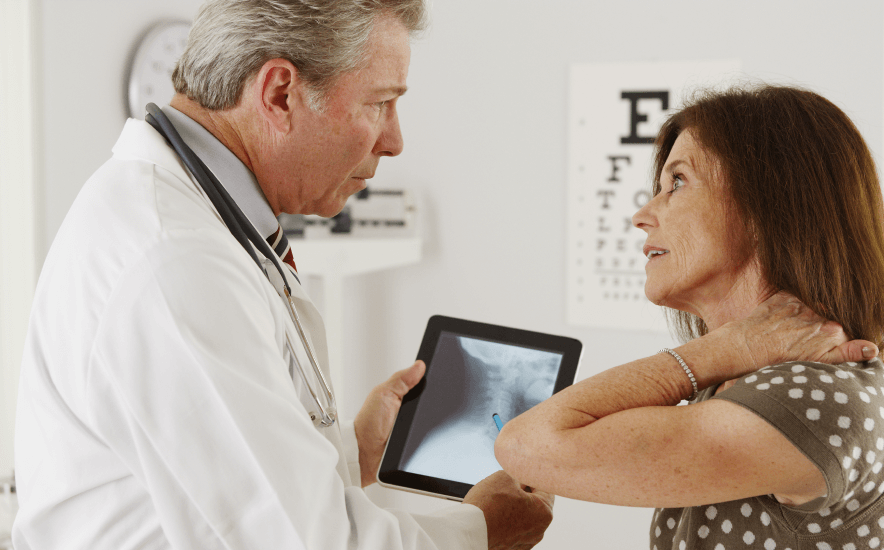
What is Cervicalgia?
Cervicalgia, commonly known as neck pain, is a widespread condition affecting a significant portion of the global population. Additionally, cervicalgia is the fourth leading cause of disability worldwide, underscoring its significant impact on public health and the urgent need for effective management strategies.



Related Diagnoses

Cervical Facet Arthritis

Cervical Radiculopathy

Cervical Muscle Spasms

Cervical Spinal Stenosis

Degenerative Disc Disease

Cervicogenic Headaches

Cervical Whiplash

Post-Surgical Cervicalgia
Expanded Guide
- Cervical Facet Arthritis: Cervical facet spondylosis, also known as cervical arthritis, is a degenerative condition affecting the joints in the cervical spine (neck). This condition occurs when the cartilage that cushions the facet joints in the neck wears down over time, leading to inflammation, pain, and stiffness in the cervical spine. Cervical spondylosis is often associated with aging, as the wear and tear on the cervical vertebrae and joints leads to the development of bone spurs, reduced disc height, and joint degeneration. Symptoms of cervical facet arthritis can include chronic neck pain, decreased range of motion, headaches, and in some cases, radiating pain or numbness in the arms or shoulders if nerve compression occurs.
- Cervical Radiculopathy: Cervical radiculopathy is a condition that occurs when a nerve in the cervical spine (neck region) becomes compressed or irritated as it exits the spinal column. This compression typically happens due to changes in the spine, such as a herniated disc, bone spurs, or degenerative changes like cervical spondylosis (arthritis). The irritation of the nerve causes pain, weakness, numbness, or other symptoms that radiate from the neck into the shoulder, arm, and hand, depending on which nerve is affected.
- Cervical Muscle Spasms: A cervical muscle spasm is an involuntary contraction or tightening of the muscles in the neck (cervical region). These spasms can cause stiffness, discomfort, and pain, and they often restrict the normal movement of the neck. Cervical muscle spasms may occur suddenly and can vary in intensity, ranging from mild tension to severe pain. They are usually the result of muscle strain or irritation but can also be caused by underlying medical conditions affecting the neck.
- Cervical Spinal Stenosis: Cervical spinal stenosis is a condition in which the spinal canal in the neck (cervical spine) narrows, putting pressure on the spinal cord and the nerves that travel through it. This narrowing can occur due to various factors, including degenerative changes, trauma, or congenital conditions. As the spinal canal narrows, it can compress the spinal cord or nerve roots, leading to pain, numbness, weakness, and other neurological symptoms that can affect the neck, arms, and sometimes the legs.
- Degenerative Disc Disease: Cervical degenerative disc disease (DDD) is a condition where the intervertebral discs in the cervical spine (the neck region) begin to deteriorate or break down, leading to pain, stiffness, and other symptoms. The intervertebral discs act as cushions between the vertebrae, allowing for movement and flexibility of the spine while absorbing shock. Over time, these discs can lose their hydration and elasticity, becoming less effective at providing support and more prone to damage. This degeneration is a natural part of aging, but it can be accelerated by injury, overuse, or other factors.
- Cervicogenic Headaches: Cervicogenic headaches are a type of secondary headache that originates from problems in the neck (cervical spine) rather than the head itself. The pain is referred from the neck structures, such as vertebrae, discs, or surrounding soft tissues, to the head. Common causes include degenerative disc disease, arthritis, neck injuries, poor posture, and compressed nerves. These headaches typically present with pain on one side of the head, starting in the neck and radiating to the forehead, temples, or behind the eyes. The pain may worsen with certain neck movements, and there is often reduced neck mobility or tenderness in the neck.
- Cervical Whiplash: Whiplash is a neck injury that occurs when the head is suddenly and forcefully jerked backward and then forward, straining or tearing the muscles, ligaments, and soft tissues in the neck. It is most commonly caused by rear-end car accidents but can also result from sports injuries, falls, or physical abuse. The symptoms of whiplash may appear immediately or develop over a few days and often include neck pain and stiffness, reduced range of motion, headaches (especially starting at the base of the skull), and shoulder or upper back pain. Some individuals may also experience tingling or numbness in the arms, dizziness, fatigue, or even cognitive issues like trouble concentrating.
- Post-Surgical Cervicalgia: Post-surgical cervicalgia refers to persistent or recurring neck pain following surgery on the cervical spine, such as discectomy, fusion, or decompression procedures. This pain can result from several factors, including scar tissue formation, incomplete resolution of the original issue, or complications with adjacent spinal segments. Additionally, strain on the muscles or ligaments, hardware complications, or nerve damage during surgery can contribute to ongoing discomfort. Symptoms typically include persistent neck pain, muscle stiffness, and reduced mobility, with pain sometimes radiating to the shoulders, upper back, or arms. In more severe cases, neurological symptoms like numbness, tingling, or weakness in the arms or hands may also occur.
Frequently Asked Questions
Have more questions? Schedule a consultation with Dr. Patel to gain additional insights and discuss treatment options. We are committed to advancing your health through patient education and a safe, minimally invasive approach.
Diagnosis usually involves a physical examination by a healthcare provider, along with a review of symptoms. Imaging studies like X-rays, MRIs, or CT scans may be used if structural issues such as herniated discs or fractures are suspected.
Treatment can include rest, physical therapy, hot or cold compresses, over-the-counter pain relievers (like NSAIDs), posture correction, neck exercises, and in some cases, prescription medications, injections, or even surgery if there is a serious underlying issue.
Cervicalgia can be acute (lasting a few days to weeks) or chronic (lasting more than three months). The duration depends on the underlying cause and the effectiveness of the treatment.
If left untreated, severe or chronic cervicalgia can lead to reduced mobility, increased pain, or in some cases, conditions like radiculopathy, where the pain radiates to other areas such as the arms.
Gramercy Center
Take the first step towards a healthier life by scheduling your initial consultation with Dr. Patel. At our clinic, we specialize in minimally invasive procedures that offer faster recovery, improved function, and decreased pain. Our client-centered approach ensures that you receive the highest quality care tailored to your unique needs. We look forward to offering you an exceptional experience.
